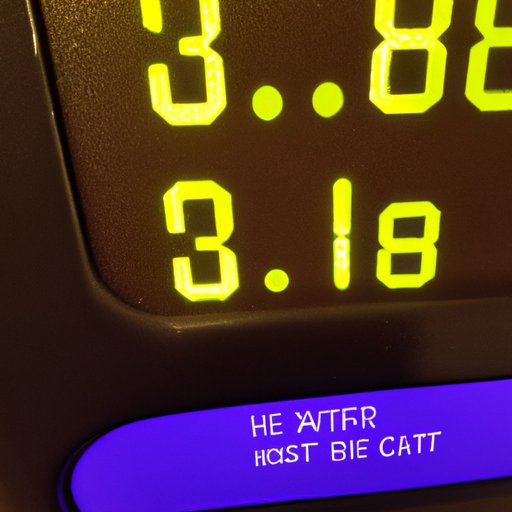Introduction
Working out in hot weather can be a great way to get a challenging and effective workout. But does it actually help you burn more calories? In this article, we’ll explore the effects of temperature on calorie burn and the advantages and disadvantages of exercising in the heat. Read on to learn more about how to maximize your calorie burn when working out in hot conditions.

A Comparison of Calories Burned During Workouts in Hot vs. Cool Temperatures
When it comes to burning calories, there are a few factors that come into play. Your body size, intensity of the workout, and type of exercise all affect how many calories you burn. Temperature is also an important factor, and research suggests that exercising in hot or humid weather may lead to increased calorie burn.
One study found that exercising in hot temperatures (85°F) led to a higher metabolic rate and greater calorie burn than exercising in cooler temperatures (68°F). The researchers concluded that the higher metabolic rate was likely due to the body’s increased effort to cool itself in the hot environment. Additionally, the study found that the total amount of calories burned during the session was higher in the hot group than in the cool group.
The Benefits of Working Out in the Heat: Does it Help You Burn More Calories?
There are several physiological benefits of working out in the heat. For one, the body has to work harder to cool itself, leading to increased calorie burn. Exercising in warmer temperatures also leads to increased blood flow, which helps deliver more oxygen and nutrients to the muscles. This can help with muscle recovery and reduce fatigue.
Additionally, research suggests that exercising in the heat may help increase fat loss. One study found that exercising in hot temperatures (90°F) resulted in a higher rate of fat oxidation (the process by which fat molecules are broken down to produce energy) than exercising in cool temperatures (60°F). The researchers concluded that the increase in fat oxidation was likely due to the body’s increased effort to cool itself in the hot environment.
While there is evidence that working out in the heat may lead to increased calorie burn and fat oxidation, it’s important to note that these results may vary depending on the individual. Everyone responds differently to different temperatures, so it’s important to listen to your body and adjust your workout accordingly.

The Advantages and Disadvantages of Working Out in Hot Weather
As with any form of exercise, there are both potential benefits and risks associated with working out in hot weather. On the plus side, exercising in the heat can lead to increased calorie burn and fat oxidation. It can also provide a more challenging workout, which can help increase strength and endurance.
However, there are also potential risks associated with working out in the heat. When exercising in hot temperatures, it’s important to stay hydrated and monitor your body’s response to the heat. If you start to feel dizzy, nauseous, or lightheaded, it’s important to stop immediately and seek medical attention if necessary.
How to Maximize Your Calorie Burn When Exercising in Hot Conditions
If you’re looking to maximize your calorie burn when exercising in hot conditions, there are a few things you can do. First, make sure you stay hydrated by drinking plenty of water before, during, and after your workout. Additionally, it’s important to wear lightweight, breathable clothing to help keep your body cool.
It’s also helpful to take frequent breaks in a cool or shaded area. This will give your body a chance to cool down and recover, allowing you to maintain a high level of intensity throughout your workout. Finally, it’s important to listen to your body and adjust your intensity level accordingly.
Does Sweating More Mean Burning More Calories When Working Out in the Heat?
Sweating is the body’s natural way of cooling itself, so it stands to reason that the more you sweat, the more calories you’ll burn. However, research suggests that this isn’t necessarily true. Sweating is primarily a result of the body’s attempt to regulate its internal temperature, not an indication of increased calorie burn.
In fact, one study found that exercising in cooler temperatures (60°F) resulted in higher calorie burn than exercising in hotter temperatures (90°F). The researchers concluded that sweating more does not necessarily mean burning more calories.
Conclusion
Exercising in hot weather can be a great way to get a challenging and effective workout. Research suggests that exercising in hot temperatures may lead to increased calorie burn and fat oxidation. However, it’s important to stay hydrated and listen to your body to ensure that you’re exercising safely and at the right intensity level. Ultimately, everyone responds differently to different temperatures, so it’s important to find what works best for you.
To recap, working out in hot weather may help you burn more calories, but it’s important to stay hydrated and listen to your body. Additionally, it’s important to remember that sweating more doesn’t necessarily mean burning more calories. With the right precautions, you can make the most of your workouts in hot weather.
(Note: Is this article not meeting your expectations? Do you have knowledge or insights to share? Unlock new opportunities and expand your reach by joining our authors team. Click Registration to join us and share your expertise with our readers.)
